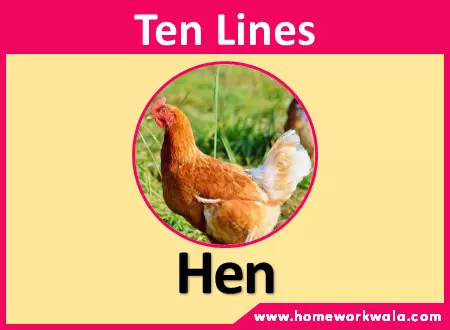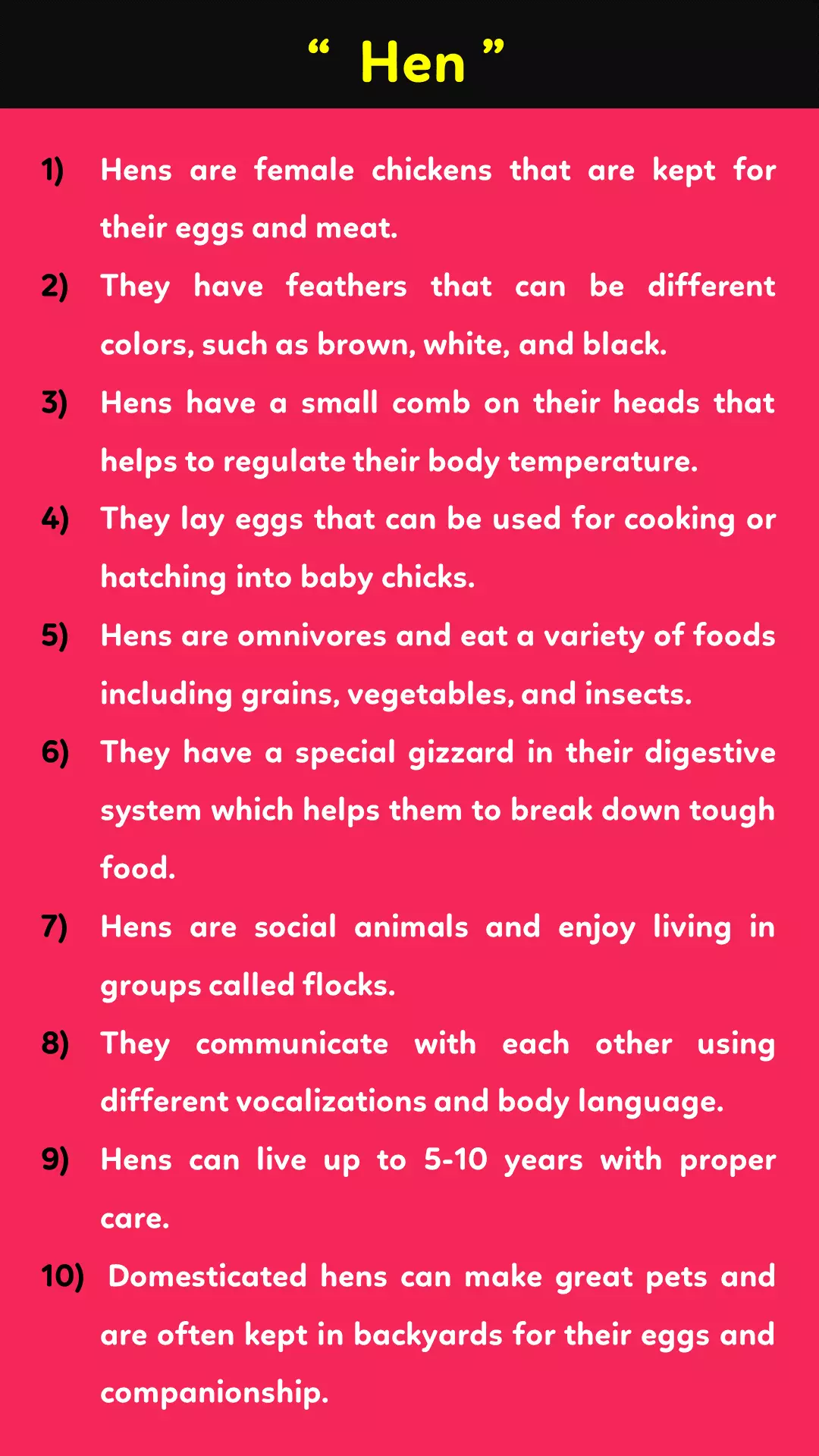Table of Content
Through this article, we are sharing 10 lines on Hen in English. This post will help those students who are looking for information about Hen in the English Language.
If any student wants to write a short essay on Hen then, this post is very useful for them. Information about Hen is very simple and easy for writing purposes.
These sentences on Hen are very short and easy to understand, so any level of student can write on this topic.

Short essay on Hen in English ( In 3 Formats )
Format-1
- Hens are female chickens that are kept for their eggs and meat.
- They have feathers that can be different colors, such as brown, white, and black.
- Hens have a small comb on their heads that helps to regulate their body temperature.
- They lay eggs that can be used for cooking or hatching into baby chicks.
- Hens are omnivores and eat a variety of foods including grains, vegetables, and insects.
- They have a special gizzard in their digestive system which helps them to break down tough food.
- Hens are social animals and enjoy living in groups called flocks.
- They communicate with each other using different vocalizations and body language.
- Hens can live up to 5-10 years with proper care.
- Domesticated hens can make great pets and are often kept in backyards for their eggs and companionship.
You May Also Like
Format-2
- Hens have a special adaptation called an egg tooth which helps them to break out of their eggshell when they hatch.
- They are very good at finding food and can scratch and dig in the ground with their feet to uncover insects and other small animals.
- Hens are often used in agriculture to control pests and weeds in fields.
- They have a unique way of dust bathing to keep their feathers clean and healthy.
- Hens are important to many different cultures and are used in various traditional dishes and celebrations.
- Roosters are the male counterpart of hens and are known for their crowing.
- Hens are sensitive to temperature and require proper shelter and ventilation to stay healthy.
- They have a hierarchy within their flock called a pecking order which determines the social standing of each hen.
- Hens have very good eyesight and can see colors and shapes very clearly.
- Chickens, including hens, are the most numerous bird species on the planet and are found all over the world.
Format-3
- Hens are domesticated birds that are commonly kept for their eggs and meat.
- They have feathers that come in various colors such as white, brown, black, and speckled.
- Hens have small heads with a pointed beak, and their eyes are located on the side of their head.
- They have two legs with sharp claws that allow them to scratch the ground for food.
- Hens are social animals and tend to live in groups called flocks.
- They communicate with each other through various sounds, including clucking and cackling.
- Hens lay eggs that are used for human consumption, and they typically lay one egg per day.
- Hens are important to the agricultural industry as they provide a significant source of protein for human consumption.
- They require proper care and nutrition to ensure their health and productivity.
- In some cultures, hens are considered symbols of motherhood and fertility.

FAQ
- What is the lifespan of a hen?
- How often do hens lay eggs?
- What should I feed my hens?
- How do I keep my hens healthy?
- How do hens communicate with each other?
- Do hens need a rooster to lay eggs?
- Can hens fly?
- How do I care for baby chicks?
Hens can live up to 8-10 years, but their egg production usually declines after the first year or two.
Most hens lay one egg per day, although this can vary depending on their breed, age, and environment.
Hens need a balanced diet that includes grains, protein, and calcium. You can feed them commercial poultry feed, or you can supplement their diet with fruits, vegetables, and other nutritious foods.
To keep your hens healthy, make sure they have access to clean water and food and provide them with a clean and comfortable living space. You should also monitor them for signs of illness and seek veterinary care if necessary.
Hens communicate with each other through a variety of sounds, including clucking, cackling, and squawking. They also use body language to convey different messages to each other.
No, hens do not need a rooster to lay eggs. However, if you want fertilized eggs that can hatch into chicks, you will need to keep a rooster with your hens.
Most domesticated hens are not strong fliers, although they can flap their wings and jump short distances. Some breeds, such as bantams, are better at flying than others.
Baby chicks need a warm and secure environment, plenty of food and water, and lots of socialization with their caretakers. You should also keep them separated from adult chickens until they are old enough to join the flock.
We hope! You will get some learning through this article. If you really like this article about Hen in English, then please share it with your friends.
We working on helping the students to do their homework in a simple and easy way. Essay writing on Hen is generally asked the students in Schools.